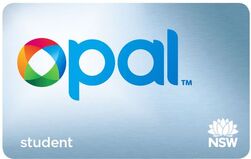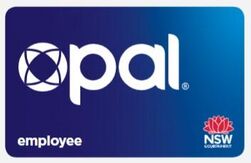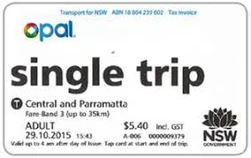Opal is a contactless smartcard ticketing system for public transport services in the greater Sydney area. The Opal card was officially launched as a trial in December 2012 on selected ferry services. Passengers can use an Opal card in the Sydney, Central Coast, Hunter Region, Blue Mountains, Southern Highlands and Illawarra areas. Currently the card is available on all Sydney Trains, NSW TrainLink intercity and Sydney Metro lines, as well as on all light rail, ferries and bus services.
History[]
Previous systems[]
Sydney has used a number of automated ticketing systems since the opening of the Eastern Suburbs Railway in June 1979. The current Sydney Automated Fare Collection System (AFC) was rolled out across all CityRail, Sydney Buses, Western Sydney Buses, Sydney Ferries and Newcastle Buses & Ferries services between 1988 and 1993. The system featured loose integration between the different modes of transport, a complex fare structure and excluded private operators.
A unified brand for the majority of public transport tickets was introduced in April 2010. MyZone was designed to simplify the fare system and remove one of the stumbling blocks to the introduction of a smart card. The AFC system was retained where it was in use, but tickets could also be used on private buses - and subsequently on the Metro Light Rail - by presenting a ticket to the driver or conductor.
Tcard[]
A replacement for the AFC based on smart card technology, named Tcard, was first announced by the Government of New South Wales in 1996, with the aim of having a system in place before the 2000 Sydney Olympics. The contract was awarded to ERG Group, but was delayed until 2002 due to a lawsuit from the losing bidder Cubic Transportation Systems, which was labelled 'dishonest' by the presiding Supreme Court of NSW judge.
The development and rollout of the system was beset with difficulties, leading the Government to terminate the contract in November 2007. The government sued ERG for $77 million who counter sued for $215m. The claim was settled in February 2012.
Revival[]
In July 2008, only months after terminating the Tcard contract, it was revealed that the smartcard system project had been revived by the government.
In August 2008 the NSW Government called for expressions of interest for the second attempt at the project, open to other Smart Card providers. In April 2010 the NSW Government awarded the contract to the Pearl Consortium, whose members are the Commonwealth Bank, Cubic Transportation Systems and Downer EDi. The system will also replace the various ticket machines used by private bus operators.
In September 2011 the new name for the system was announced as 'Opal', chosen from a selection of 665 names. Transport for New South Wales said Opal was chosen because it was 'uniquely Australian', short, and easy to say. As well as the opal being Australia's national gemstone, the black opal is the New South Wales gemstone symbol.
Rollout[]
The first stage of the Opal card rollout commenced on 7 December 2012 as a trial on the Neutral Bay to Circular Quay ferry service followed by the Manly to Circular Quay service on 8 April 2013. By the end of 2013, the card could be used on all ferry services. From 14 June 2013 it was enabled for train services on the City Circle and Eastern Suburbs lines. It is now available on all Sydney Metro, Sydney Trains and NSW TrainLink Intercity services.
Cards[]
The system itself is quite simple. The cards are MIFARE DESFIRE EV2 smartcards, which are tapped at validators at the start and end of a journey. The card communicates with the validator using NFC (near field communications). Although the validator does send information back to TfNSW servers, it also writes information to the card. In case there is a discrepancy between the back-end and the card, the information on the card is always right.
Types[]
There are six different Opal card fare types, each with their own easily identifiable colour:
| Card Type | Colour | Fare Difference | Who can use | How to obtain |
|---|---|---|---|---|
| Adult | Black | Anyone | Online
Phone Retailer | |
| Child/Youth | Green | Half fare | Those aged 4-15
(16-18 if still attending school) | |
| Concession | Silver | Half fare | Those receiving certain government benefits (e.g. domestic tertiary students, jobseekers) | Online
Phone |
| Senior/Pensioner | Gold | Half fare
$2.50 day cap |
Those over 65 or receiving certain government benefits (e.g. war veteran) | |
| Student | Blue | Free Travel | Those qualifying for SSTS (School Student Travel Scheme) | |
| Employee | Blue | Free Travel | Most TfNSW employees and Police | N/A |
| Single Trip | White
(Cardboard) |
Anyone | Top-up machine |
For most concessions, a concession card/pass must also be carried at all times and shown to transit officers on request.
Gallery[]
Top-up[]
Machines are provided at some train/light rail/ferry stations to add money to the card. There are three different versions of these machines:
- Phase 1: Can only top-up cards using a credit card (Converted from old paper ticket machines, and so only found at train stations)
- Phase 2: Can top-up cards and issue single-trip cards using a credit card only
- Phase 2: Can top-up cards and issue single-trip cards using either a credit card or cash
Alternatively top-ups can be done at retailers, online or by phone. Phone/online top-ups need to be sent over the internet to station validators so that it is written to the card. This can take up to 1 hour.








